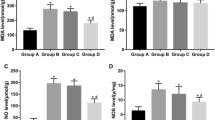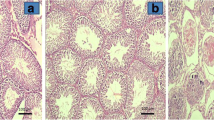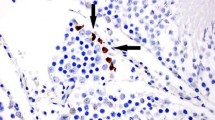Abstract
Testicular torsion is an important clinical urgency. Similar mechanisms occurred after detorsion of the affected testis as in the ischemia reperfusion (I/R) damage. This study was designed to investigate the effects of erythropoietin (EPO) treatment after unilateral testicular torsion. Fifty male Sprague-Dawley rats were divided into five groups. Group 1 underwent a sham operation of the right testis under general anesthesia. Group 2 was same as sham, and EPO (3,000 IU/kg) infused i.p., group 3 underwent a similar operation but the right testis was rotated 720° clockwise for 1 h, maintained by fixing the testis to the scrotum, and saline infused during the procedure. Group 4 underwent similar torsion but EPO was infused half an hour before the detorsion procedure, and in group 5, EPO was infused after detorsion procedure. Four hours after detorsion, ipsilateral and contralateral testes were taken out for evaluation. Treatment with EPO improved testicular structures in the ipsilateral testis but improvement was less in the contralateral testis histologically, but EPO treatment decreased germ cell apoptosis in both testes following testicular IR. TNF-α, IL-1β, IL-6 and nitrite levels decreased after EPO treatment especially in the ipsilateral testis. We conclude that testicular I/R causes an increase in germ cell apoptosis both in the ipsilateral and contralateral testes. Eryhropoietin has antiapoptotic and anti-inflammatory effects following testicular torsion.




Similar content being viewed by others
References
Horica CA, Hadziselimovic F, Kreutz G, Bandhauer K (1982) Ultrastructural studies of the contorted and contralateral testicle in unilateral testicular torsion. Eur Urol 8(6):358–362
Thomas WE, Williamson RC (1983) Diagnosis and outcome of testicular torsion. Br J Surg 70(4):213–216
Filho DW, Torres MA, Bordin AL, Crezcynski-Pasa TB, Boveris A (2004) Spermatic cord torsion, reactive oxygen and nitrogen species and ischemia-reperfusion injury. Mol Aspects Med 25(1–2):199–210
Lysiak JJ (2004) The role of tumor necrosis factor-alpha and interleukin-1 in the mammalian testis and their involvement in testicular torsion and autoimmune orchitis. Reprod Biol Endocrinol 10(2):9
Akgur FM, Kilinc K, Tanyel FC, Buyukpamukcu N, Hicsonmez A (1994) Ipsilateral and contralateral testicular biochemical acute changes after unilateral testicular torsion and detorsion. Urology 44(3):413–418
Lacombe C, Mayeux P (1999) The molecular biology of erythropoietin. Nephrol Dial Transplant 14(suppl. 2):22–28
Chikuma M, Masuda S, Kobayashi T, Nagao M, Sasaki R (2000) Tissue- spesific regulation of erythropoietin production in the murine kidney,brain and uterus. Am J Physiol Endocrinol Metab 279:E1242–E1248
Magnanti M, Gandini O, Giuliani L, Gazzaniga P, Marti HH, Gradilone A, Frati L, Agliano AM, Gassmann M (2001) Erythropoietin expression in primary rat Sertoli and peritubular myoid cells. Blood 1 98(9):2872–2874
Yamamoto Y, Sofikitis N, Miyagawa I (1997) Effects of erythropoietin, bromocryptine and hydralazine on testicular function in rats with chronic renal failure. Andrologia 29(3):141–144
Sepodes B, Maio R, Pinto R, Sharples E, Oliveira P, McDonald M, Yaqoob M, Thiemermann C, Mota-Filipe H (2006) Recombinant human erythropoietin protects the liver from hepatic ischemia-reperfusion injury in the rat. Transpl Int 19(11):919–926
Liu X, Shen J, Jin Y, Duan M, Xu J (2006) Recombinant human erythropoietin (rhEPO) preconditioning on nuclear factor-kappa B (NF-kB) activation & proinflammatory cytokines induced by myocardial ischaemia-reperfusion. Indian J Med Res 124(3):343–354
Tunctan B, Abacioglu N (1998) J Pharm Sci 23:161–170
Johnson DW, Pat B, Vesey DA, Guan Z, Endre Z, Gobe GC (2006) Delayed administration of darbepoetin or erythropoietin protects against ischemic acute renal injury and failure. Kidney Int 69(10):1806–1813
Spierings DC, de Vries EG, Vellenga E, van den Heuvel FA, Koornstra JJ, Wesseling J, Hollema H, de Jong S (2004) Tissue distribution of the death ligand TRAIL and its receptors. J Histochem Cytochem 52(6):821–831
Grataroli R, Vindrieux D, Gougeon A, Benahmed M (2002) Expression of tumor necrosis factor-alpha-related apoptosis-inducing ligand and its receptors in rat testis during development. Biol Reprod 66(6):1707–1715
Rival C, Theas MS, Guazzone VA, Lustig L (2006) Interleukin-6 and IL-6 receptor cell expression in testis of rats with autoimmune orchitis. J Reprod Immunol 70(1–2):43–58
Zoja C, Wang JM, Bettoni S, Sironi M, Renzi D, Chiaffarino F, Abboud HE, Van Damme J, Mantovani A, Remuzzi G et al (1991) Interleukin-1 beta and tumor necrosis factor-alpha induce gene expression and production of leukocyte chemotactic factors, colony-stimulating factors, and interleukin-6 in human mesangial cells. Am J Pathol 138(4):991–1003
Ishikawa T, Morris PL (2006) Interleukin-1beta signals through a c-Jun N-terminal kinase-dependent inducible nitric oxide synthase and nitric oxide production pathway in Sertoli epithelial cells. Endocrinology 147(11):5424–5430
Vera Y, Erkkila K, Wang C, Nunez C, Kyttanen S, Lue Y, Dunkel L, Swerdloff RS, Sinha Hikim AP (2006) Involvement of p38 mitogen-activated protein kinase and inducible nitric oxide synthase in apoptotic signaling of murine and human male germ cells after hormone deprivation. Mol Endocrinol 20(7):1597–1609
Basar MM, Kisa U, Tuglu D, Yilmaz E, Basar H, Caglayan O, Batislam E (2006) Testicular nitric oxide and thiobarbituric acid reactive substances levels in obstructive azoospermia: a possible role in pathophysiology of infertility. Mediators Inflamm 3:27458
Reddy MM, Mahipal SV, Subhashini J, Reddy MC, Roy KR, Reddy GV, Reddy PR, Reddanna P (2006) Bacterial lipopolysaccharide-induced oxidative stress in the impairment of steroidogenesis and spermatogenesis in rats. Reprod Toxicol 22(3):493–500
Meroni SB, Subuo AM, Cigorraga SB (2000) Interleukin-1beta regulates nitric oxide production and gamma-glutamyl transpeptidase activity in sertoli cells. Androl 21(6):855–861
Ozokutan BH, Kucukaydin M, Muhtaroglu S, Tekin Y (2000) The role of nitric oxide in testicular ischemia-reperfusion injury. J Pediatr Surg 35(1):101–103
Acknowledgments
This study was supported by TUBITAK (The Scientific and Technological Research Council of Turkey) project no: 104S412 (SBAG-AYD-487).
Author information
Authors and Affiliations
Corresponding author
Rights and permissions
About this article
Cite this article
Yazihan, N., Ataoglu, H., Koku, N. et al. Protective role of erythropoietin during testicular torsion of the rats. World J Urol 25, 531–536 (2007). https://doi.org/10.1007/s00345-007-0200-9
Received:
Accepted:
Published:
Issue Date:
DOI: https://doi.org/10.1007/s00345-007-0200-9




